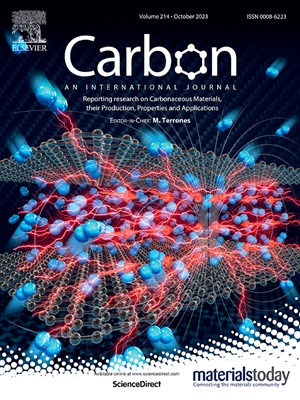MXene-CNTs/Co dielectric-electromagnetic synergistic composites with multi-heterogeneous interfaces for microwave absorption
IF 10.5
2区 材料科学
Q1 CHEMISTRY, PHYSICAL
引用次数: 0
Abstract
In view of the growing concern over electromagnetic wave pollution, the evolution of efficient microwave absorbing (MA) composites has emerged as a pivotal research area for scientists and engineers. In this study, MXene-CNTs/Co (MCC) composites with tunable and efficient MA properties were successfully prepared from a structural design perspective that capitalizes on dielectric-magnetic synergy. The electromagnetic properties of the composites were effectively regulated by adjusting the length and content of the CNTs. As expected, the design of the MCC composite absorber has a minimum reflection loss (RLmin) of −62.53 dB with a matched thickness of 1.59 mm. With an effective absorption bandwidth (EAB) of 4.20 GHz (12.48–16.68 GHz) and a matched thickness of 1.38 mm, the RLmin remains an impressive −41.29 dB. The exceptional MA characteristics are ascribed to its distinctive three-dimensional (3D) electromagnetic network configuration, which optimizes impedance matching and augments multi-component polarization loss and reflection/scattering capabilities. The findings of this study offer novel insights and methodologies for the advancement of efficient and tunable microwave absorbing materials.
具有多异质界面的 MXene-CNTs/Co 微波吸收介电电磁协同复合材料
本文章由计算机程序翻译,如有差异,请以英文原文为准。
求助全文
约1分钟内获得全文
求助全文
来源期刊

Carbon
工程技术-材料科学:综合
CiteScore
20.80
自引率
7.30%
发文量
0
审稿时长
23 days
期刊介绍:
The journal Carbon is an international multidisciplinary forum for communicating scientific advances in the field of carbon materials. It reports new findings related to the formation, structure, properties, behaviors, and technological applications of carbons. Carbons are a broad class of ordered or disordered solid phases composed primarily of elemental carbon, including but not limited to carbon black, carbon fibers and filaments, carbon nanotubes, diamond and diamond-like carbon, fullerenes, glassy carbon, graphite, graphene, graphene-oxide, porous carbons, pyrolytic carbon, and other sp2 and non-sp2 hybridized carbon systems. Carbon is the companion title to the open access journal Carbon Trends. Relevant application areas for carbon materials include biology and medicine, catalysis, electronic, optoelectronic, spintronic, high-frequency, and photonic devices, energy storage and conversion systems, environmental applications and water treatment, smart materials and systems, and structural and thermal applications.
 求助内容:
求助内容: 应助结果提醒方式:
应助结果提醒方式:


